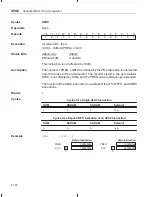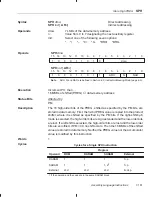
RPT
Repeat Next Instruction
7-146
Syntax
RPT
dma Direct
addressing
RPT
ind [, ARn]
Indirect addressing
RPT #
k
Short immediate
Operands
dma:
7 LSBs of the data-memory address
n:
Value from 0 to 7 designating the next auxiliary register
k:
8-bit short immediate value
ind:
Select one of the following seven options:
* *+ *– *0+ *0– *BR0+ *BR0–
RPT
dma
15
14
13
12
11
10
9
8
7
6
5
4
3
2
1
0
0
0
0
0
1
0
1
1
0
dma
RPT
ind [, ARn]
15
14
13
12
11
10
9
8
7
6
5
4
3
2
1
0
0
0
0
0
1
0
1
1
1
ARU
N
NAR
Note:
ARU, N, and NAR are defined in Section 6.3,
Indirect Addressing Mode (page 6-9).
RPT #
k
15
14
13
12
11
10
9
8
7
6
5
4
3
2
1
0
1
0
1
1
1
0
1
1
k
Execution
Increment PC, then ...
Event
Addressing mode
(data-memory address)
→
RPTC
Direct or indirect
k
→
RPTC
Short immediate
Status Bits
None
Description
The repeat counter (RPTC) is loaded with the content of the addressed data-
memory location if direct or indirect addressing is used; it is loaded with an 8-bit
immediate value if short immediate addressing is used. The instruction follow-
ing the RPT is repeated
n times, where n is the initial value of the RPTC plus
1. Since the RPTC cannot be saved during a context switch, repeat loops are
regarded as multicycle instructions and are not interruptible. The RPTC is
cleared to 0 on a device reset.
RPT is especially useful for block moves, multiply/accumulates, and normal-
ization. The repeat instruction itself is not repeatable.
Words
1
Opcode
















































